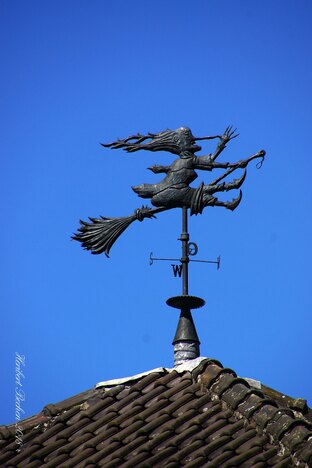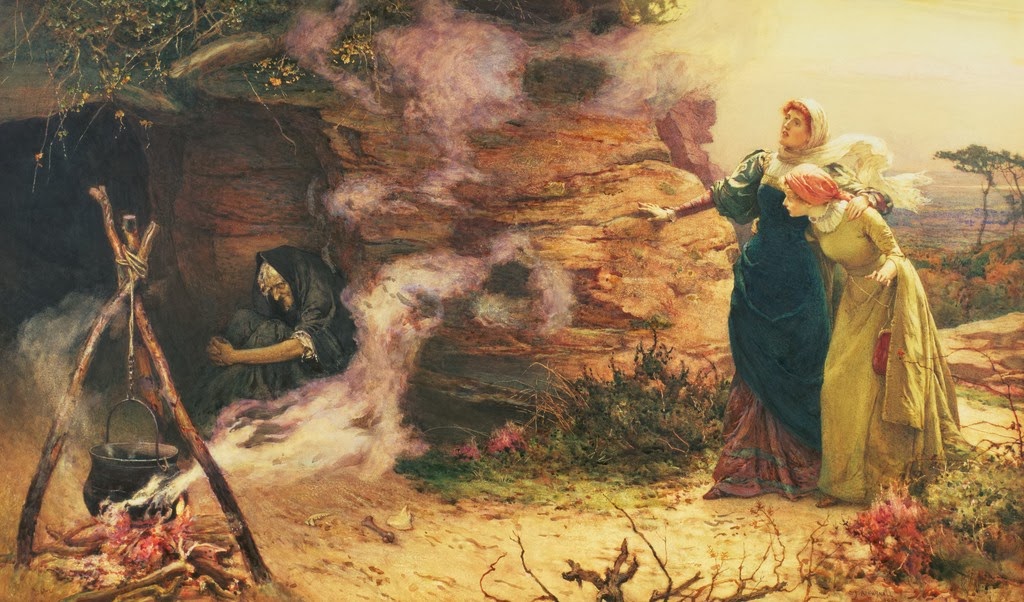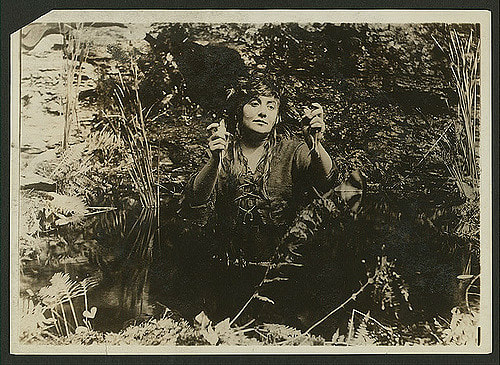"There's a sense of power that seems to be integral to the modern image of the witch; however, this was not always the case."-margaret Gray
Women and girls are obsessed with the witch. There’s something enchanting about the idea of a woman who can cast spells, who is in control of not only herself but what’s around her, of a girl who is comfortable in her own skin, in her own power, comfortable with who she is and undeniably herself. There’s a sense of power that seems to be integral to the modern image of the witch; however, this was not always the case.
The idea of witches, witchcraft, and the negative connotations that came with them started in the early 1600s. In the bustling Virginia Colony of Jamestown, residents began to enforce the idea of the witch as a devil worshiper. This stereotype likely started with the Virginian Native Americans who lived around Jamestown; to the racist Europeans these ceremonies were seen as sinful and the worldwide fear of the witch was born.
Everyone knows about the Salem Witch Trials, which took place between 1692 and 1693, but there is evidence of the persecution of “witches” as early as 1622. Colonists living in Jamestown began to accuse one another of witchcraft; though there were fewer trials in 1622 Virginia than there were in 1692 Salem, the idea of witchcraft as something evil and inherently wrong persisted. Cases and trials having to do with witchcraft ranged from accusations of civil defamation (the act of defaming someone by committing a crime or an offense) to criminal allegations.
Even though the idea of witches and the negative opinions that surround them stemmed from Jamestown Virginia, they spread like wildfire in the next thirty years. The place that seemed to be the most affected by the continent-wide distrust of arcane females was the Massachusetts Bay colony. The colony housed Salem and a handful of other towns that experienced an influx of fear-driven hatred towards women (and a couple men) who were branded as witches. In the peak of the witch craze almost anything could be seen as an indicator of a witch; there was no woman who was safe from the widespread panic that took hold of Massachusetts. Any natural disaster or problem in the colony was pinned on a woman who did not fit the mold of the weak female.
The stereotypical concept of a witch- an evil, pointy-hat-wearing hag- was rooted in early 1600s, but paganism, often used as a synonym for witchcraft, has been practiced by humans for thousands of years. Historians agree that the earliest humans worshipped a collection of gods or spirits rooted in their environment; people would pay homage to a large tree outside of their village or a rock that sat next to their house, believing that these natural monuments contained spirits that, when pleased, would grant the residents of these early villages with luck, good hunting, or good harvest (after the agricultural revolution).
The idea of witches, witchcraft, and the negative connotations that came with them started in the early 1600s. In the bustling Virginia Colony of Jamestown, residents began to enforce the idea of the witch as a devil worshiper. This stereotype likely started with the Virginian Native Americans who lived around Jamestown; to the racist Europeans these ceremonies were seen as sinful and the worldwide fear of the witch was born.
Everyone knows about the Salem Witch Trials, which took place between 1692 and 1693, but there is evidence of the persecution of “witches” as early as 1622. Colonists living in Jamestown began to accuse one another of witchcraft; though there were fewer trials in 1622 Virginia than there were in 1692 Salem, the idea of witchcraft as something evil and inherently wrong persisted. Cases and trials having to do with witchcraft ranged from accusations of civil defamation (the act of defaming someone by committing a crime or an offense) to criminal allegations.
Even though the idea of witches and the negative opinions that surround them stemmed from Jamestown Virginia, they spread like wildfire in the next thirty years. The place that seemed to be the most affected by the continent-wide distrust of arcane females was the Massachusetts Bay colony. The colony housed Salem and a handful of other towns that experienced an influx of fear-driven hatred towards women (and a couple men) who were branded as witches. In the peak of the witch craze almost anything could be seen as an indicator of a witch; there was no woman who was safe from the widespread panic that took hold of Massachusetts. Any natural disaster or problem in the colony was pinned on a woman who did not fit the mold of the weak female.
The stereotypical concept of a witch- an evil, pointy-hat-wearing hag- was rooted in early 1600s, but paganism, often used as a synonym for witchcraft, has been practiced by humans for thousands of years. Historians agree that the earliest humans worshipped a collection of gods or spirits rooted in their environment; people would pay homage to a large tree outside of their village or a rock that sat next to their house, believing that these natural monuments contained spirits that, when pleased, would grant the residents of these early villages with luck, good hunting, or good harvest (after the agricultural revolution).
The persecution of pagans, which most likely started with the creation of organized religion itself, has been a constant throughout ancient history. The first religions included Mesopotamian and Egyptian religions which were polytheistic (multiple gods) and, in many ways, were very similar to the early Pagan beliefs. However, the organization and commonality that was enforced obliterated the earlier paganistic rituals that early humans practiced.
The first monotheistic religion was Judaism, and with monotheism came an increased sense of hatred towards pagans, witches, and “devil worshippers.” Though Judaism had a far more varied and sometimes gentle attitude towards witches, there were still witch hunts throughout the history of Judaism; some Jewish priests believed that witches were Quasi-Demons (or lesser demons). Others, in different geographical settings, had an equally negative view of witchcraft but believed that all women in some time of their lives would take part in it.
In both the Torah (the holy Jewish book) and the Bible (the holy Christian book) the general opinion on witches is very negative. Witchcraft in the Torah is considered a capital offense; both men and women can be prosecuted on charges of witchery. Female witches are depicted throughout the book in positions of power; queens, nobles, and many others are described as witches. Tales of men defeating witches and robbing them of their power exist throughout Judaism.
The Bible, however, and people who practiced Christianity, took an even more extreme stance on witchcraft. The Bible specifically states “thou shalt not permit a sorceress to live” in Exodus 22:18 and “there shall not be among you a witch” in Galatians 5:19. The view on witches throughout Christianity was constant: a witch must be killed. The first recorded witch trial was as early as 1234. She was sentenced to a water trial. If she drowned she was not a witch and if she floated she was arcane. She drowned without any record of what her name was or what she did that warranted the accusations of witchcraft. Witches were responsible for illness, bad harvest, miscarriage, and a myriad of other blights; in the peak of the witch craze in colonial America a miscarriage or similar disaster could start a town-wide hunt for a woman who could’ve caused the problems that were ever-so common in the early and developing towns that constituted North America.
In short, a witch was someone who did not allow herself to be defined by the patriarchy and masculinity that ravaged the leadership systems of colonial america. Let’s recap: the witch, the empowered, strong female, often the only powerful female around, is the one being oppressed, branded as sinful and evil, and then brutally murdered. What does that say about our society? What happens when little girls have no strong role models of the same gender as them? What happens when the female leaders, the female rulers, often the only females who have any sense of control over themselves are called devil-worshippers?
The first monotheistic religion was Judaism, and with monotheism came an increased sense of hatred towards pagans, witches, and “devil worshippers.” Though Judaism had a far more varied and sometimes gentle attitude towards witches, there were still witch hunts throughout the history of Judaism; some Jewish priests believed that witches were Quasi-Demons (or lesser demons). Others, in different geographical settings, had an equally negative view of witchcraft but believed that all women in some time of their lives would take part in it.
In both the Torah (the holy Jewish book) and the Bible (the holy Christian book) the general opinion on witches is very negative. Witchcraft in the Torah is considered a capital offense; both men and women can be prosecuted on charges of witchery. Female witches are depicted throughout the book in positions of power; queens, nobles, and many others are described as witches. Tales of men defeating witches and robbing them of their power exist throughout Judaism.
The Bible, however, and people who practiced Christianity, took an even more extreme stance on witchcraft. The Bible specifically states “thou shalt not permit a sorceress to live” in Exodus 22:18 and “there shall not be among you a witch” in Galatians 5:19. The view on witches throughout Christianity was constant: a witch must be killed. The first recorded witch trial was as early as 1234. She was sentenced to a water trial. If she drowned she was not a witch and if she floated she was arcane. She drowned without any record of what her name was or what she did that warranted the accusations of witchcraft. Witches were responsible for illness, bad harvest, miscarriage, and a myriad of other blights; in the peak of the witch craze in colonial America a miscarriage or similar disaster could start a town-wide hunt for a woman who could’ve caused the problems that were ever-so common in the early and developing towns that constituted North America.
In short, a witch was someone who did not allow herself to be defined by the patriarchy and masculinity that ravaged the leadership systems of colonial america. Let’s recap: the witch, the empowered, strong female, often the only powerful female around, is the one being oppressed, branded as sinful and evil, and then brutally murdered. What does that say about our society? What happens when little girls have no strong role models of the same gender as them? What happens when the female leaders, the female rulers, often the only females who have any sense of control over themselves are called devil-worshippers?
The word witch changed and continues to change from the literal definition. It became less and less of a descriptor of a person who cast spells and more of a way to prosecute women who did not fit into society. A way to get rid of women who were strong. A way to continue perpetuating the patriarchy.
The answer to what happens when a country removes its witches is Trump’s America. An America where women have no control over themselves, where they are not listened to or respected, where decisions are made for them before they are even born. Ohio’s heartbeat abortion law just passed the senate. Brett Kavanaugh was confirmed to the Supreme Court. Over and over strong women- all women- are burnt at metaphorical stakes just like they were burnt at real ones hundreds of years ago.
It is in this way that the witch hunt mentality continues through modern times. The oppression of the witch is something that is relevant to everyone who is pushing to generate equality in America. Our ancestors hunted witches and continued the patriarchy; modern leaders continue this tradition.
Evidence of this continuation of the witch hunt can be found throughout our modern political and personal landscape. Laws continue to be passed the limit the modern women and take more and more control of her body. Just as our ancestors’ drowning tests could not be won, neither can the judgements made about women be avoided. Anything about a woman can be warped into something that’s a negative trait- just as anything about a woman in the 1600s would brand her a witch. Judgement, limitation, and lack of control are all symptoms of a bigger problem in America- the extension of the witch hunt that plagued our ancestors.
The answer to what happens when a country removes its witches is Trump’s America. An America where women have no control over themselves, where they are not listened to or respected, where decisions are made for them before they are even born. Ohio’s heartbeat abortion law just passed the senate. Brett Kavanaugh was confirmed to the Supreme Court. Over and over strong women- all women- are burnt at metaphorical stakes just like they were burnt at real ones hundreds of years ago.
It is in this way that the witch hunt mentality continues through modern times. The oppression of the witch is something that is relevant to everyone who is pushing to generate equality in America. Our ancestors hunted witches and continued the patriarchy; modern leaders continue this tradition.
Evidence of this continuation of the witch hunt can be found throughout our modern political and personal landscape. Laws continue to be passed the limit the modern women and take more and more control of her body. Just as our ancestors’ drowning tests could not be won, neither can the judgements made about women be avoided. Anything about a woman can be warped into something that’s a negative trait- just as anything about a woman in the 1600s would brand her a witch. Judgement, limitation, and lack of control are all symptoms of a bigger problem in America- the extension of the witch hunt that plagued our ancestors.



